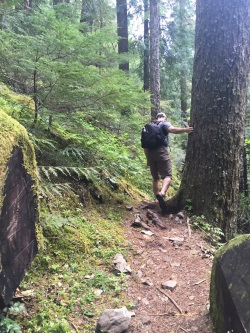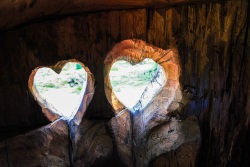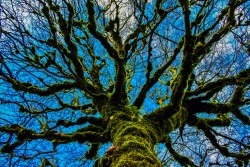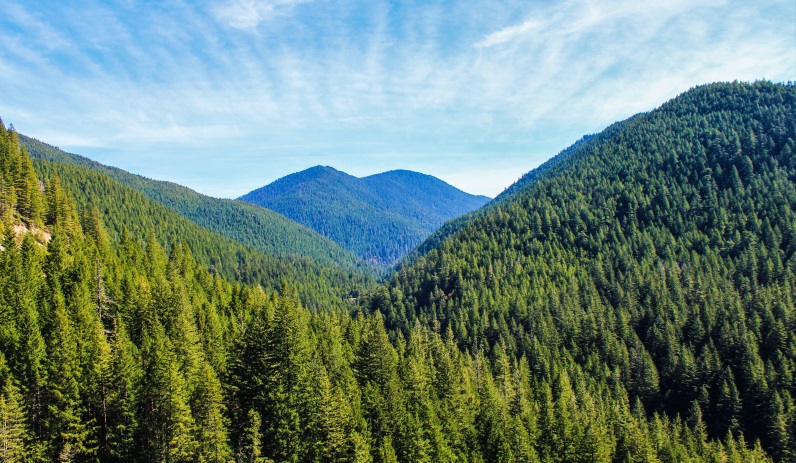I have a deep appreciation for trees. It’s the reason why I chose to work for Opal Creek Ancient Forest Center. I can easily trace the origin of this appreciation to youthful adventures, but it made me curious about additional moments in my life that have helped solidify a love for our wood-based cohabitants. When thinking about my impactful moments with trees I discovered that the significant moments all happened in different stages of my life, from my early tree climbing days to my present fascination with canopies, and ultimately shaped the path to my present day.
Backyard Pine Tree – pushing myself behind my comfort zone and perceived capabilities
Growing up we had a pine tree in our back yard. By Doug Fir standards it was a tiny tree, but to a young kid it was a skyscraper. I remember watching my brother and his friends climb the tree with ease, while I typically stuck to the lower branches. I wanted to go higher but I was scared. Similar to a novice or fatigued rock climber, my legs would shake uncontrollably as I hesitated to climb higher. So I decided to make the top of the tree my goal and began to climb independent of others in order to avoid the reckless feelings of inadequacy and embarrassment.
 With each climb I felt stronger and more secure in my foot and hand placements so I pushed further each time. Towards the top the tree had made a perfect ladder of sorts with its branches. I remember the relief that I felt upon reaching that point for the first time – it was a short and easy climb to the canopy peak after that. When I finally reached the top of the tree I noticed that I was higher up than my own house. As I looked around I noticed I was higher than most houses in the neighborhood. In fact, I was so high up that I could look eastward to downtown Milwaukee and see actual skyscrapers. The sense of accomplishment that I felt in that moment has been a driving force for many of the adventures that I have had in my life.
With each climb I felt stronger and more secure in my foot and hand placements so I pushed further each time. Towards the top the tree had made a perfect ladder of sorts with its branches. I remember the relief that I felt upon reaching that point for the first time – it was a short and easy climb to the canopy peak after that. When I finally reached the top of the tree I noticed that I was higher up than my own house. As I looked around I noticed I was higher than most houses in the neighborhood. In fact, I was so high up that I could look eastward to downtown Milwaukee and see actual skyscrapers. The sense of accomplishment that I felt in that moment has been a driving force for many of the adventures that I have had in my life.
The Giving Tree – learning how trees give back to the earth and benefit me as an animal
Shel Silverstein’s classic children’s book had a profound effect on me as a child. Even as a youth I remember being emotionally moved by the tree’s compassion for the human as he moved through his life. While, even as a kid, I recognized that trees do not openly encourage the picking of their fruit or the cutting of their branches, it did make me curious to discover what a tree’s purpose actually was. So I began my own independent research, fueled by sheer curiosity, and learned how trees act as a natural filter for the air that sustains me and how they provide shelter and sustenance for other animals. My appreciation for trees is rooted in that independent research project.
Northwoods – moving beyond my fears and hesitations into magical places
Growing up in the Milwaukee Metro I had the typical urban upbringing of playing on cement and manicured lawns. While my neighborhood had planted trees and well-groomed parks I never fully felt comfortable in the woods, especially at night. As a young adult I was fortunate to find myself working for a camp in the Northwoods of Wisconsin in the midst of the Chequamegon National Forest.
When you live in the forest and have to walk 30 yards from your cabin to the outhouse at 2am, you stop feeling concerned about the sounds of the forest and instead you begin to listen to them and understand those sounds as threatening or non-threatening.
Quickly I learned that the sounds coming from the forest at night were not large terrifying predators rushing towards me, but often times a small nocturnal mammal that could fit in the palm of your hand scurrying around the fallen foliage eagerly searching for food. It’s easy to take a small aspect of life, such as spiders, and within our mind amplify their presence into live-action versions of Aragog from Harry Potter and react negatively as a result. As Dumbadore said to Harry, “it is the unknown we fear when we look upon death and darkness, nothing more,” so I began to learn more about my surroundings by exploring the darkness with others as a way to overcome my hesitations. Now my favorite time of day to be in the forest is at night, especially when alone, for I find a peaceful calm in those moments and enjoy the heightened senses beyond my biased vision.
Redwoods – spiritual cathedral; the energy of old-growth
 Religion has never played a role in my life and I would say that I understood very little about my own spirituality until the age of 30. The awakening happened when I found a cathedral that I finally felt comfortable in – the Redwoods of Northern California. The peace, tranquility, and security that I feel when I’m among the towering giants is truly therapeutic and has imprinted nature as a sacred space for me. As a youth I saw the forest as just a bunch of trees, but now as an adult, it’s less about what I see in the forest and more about the reassuring energy that I feel when I’m walking through a grove of trees. I’m more confident and secure of my place in the world in these moments and I’m reminded that there is a bigger picture beyond the human existence.
Religion has never played a role in my life and I would say that I understood very little about my own spirituality until the age of 30. The awakening happened when I found a cathedral that I finally felt comfortable in – the Redwoods of Northern California. The peace, tranquility, and security that I feel when I’m among the towering giants is truly therapeutic and has imprinted nature as a sacred space for me. As a youth I saw the forest as just a bunch of trees, but now as an adult, it’s less about what I see in the forest and more about the reassuring energy that I feel when I’m walking through a grove of trees. I’m more confident and secure of my place in the world in these moments and I’m reminded that there is a bigger picture beyond the human existence.
Tree Systems – we’re not so different; neuron system of the brain
As a kid I loved to draw trees. They were easy and fun because after the two parallel lines for the trunk you just made the symbol “V” repeatedly in any opening and suddenly you have a beautiful deciduous tree in the winter. What I didn’t realize at the time was the connection of synapses that I was unintentionally drawing; I thought it was just a tree. Thanks to my cognitive psychology courses in undergrad I came to learn about the vast network of neurons that control our bodily kinetics and personality temperament.
 It wasn’t until I took up photography though that I made the real connection between the similarity of a tree branch and root system and the human animal brain. In the same fashion that our brain adapts and grows to extend and connect our synapses as we age, the tree root and branch system stretch out for nutrients and sunlight in order to grow. Chief Seattle is quoted as saying, “The earth does not belong to us, we belong to the earth.” We can look out at a series of trees, or see a pack of wolves wander about a field in the distance and call that nature, but nature is more than just a “wild” experience. Everything we do is nature, it’s just that humans hide within structures and behind belief systems that develop human-biased lenses.
It wasn’t until I took up photography though that I made the real connection between the similarity of a tree branch and root system and the human animal brain. In the same fashion that our brain adapts and grows to extend and connect our synapses as we age, the tree root and branch system stretch out for nutrients and sunlight in order to grow. Chief Seattle is quoted as saying, “The earth does not belong to us, we belong to the earth.” We can look out at a series of trees, or see a pack of wolves wander about a field in the distance and call that nature, but nature is more than just a “wild” experience. Everything we do is nature, it’s just that humans hide within structures and behind belief systems that develop human-biased lenses.
In the end, in my mind, if anything truly has a right to be it’s a tree, and I’m proud to work for an organization born from the conservation of these precious earth resources that do more for existence than just provide humans with structures and byproducts. I’ll conclude with one final quote:
“The tree which moves some to tears of joy is in the eyes of others only a green thing that stands in the way. Some see nature all ridicule and deformity… and some scarce see nature at all. But to the eyes of the [person] of imagination, nature is imagination itself.” ― William Blake


